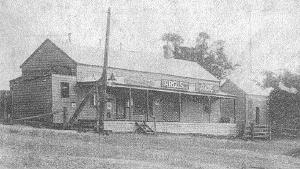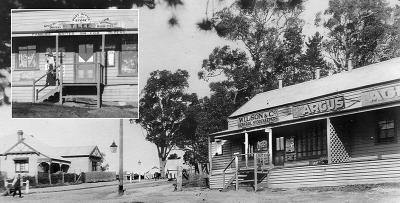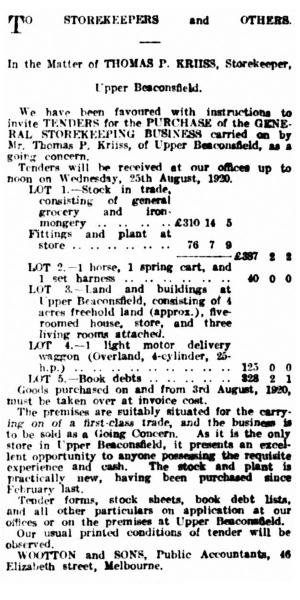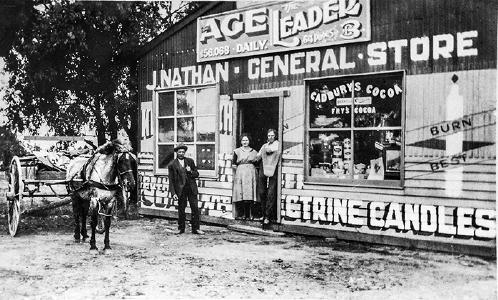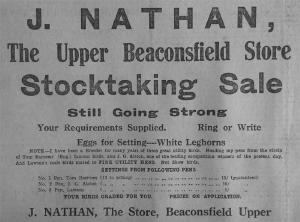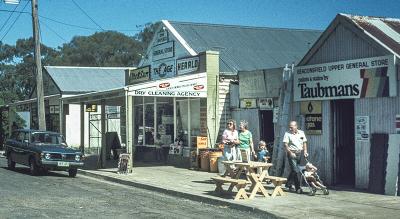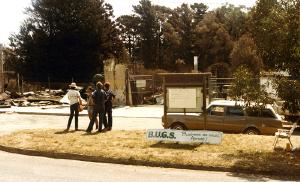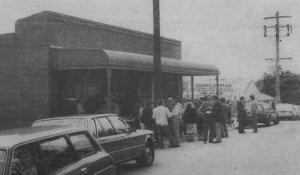History of the General Store
Upper Beaconsfield had a number of stores dotted around the area, but there is little information obtainable about them. They were probably part of people's properties, rather than purpose-built stores. In the 1890s Charles L. Schlipalius had a store and post-office near the first state school, Paul Einsiedel had a shop or store on the corner of A'Beckett Road. Later, after the post office was built in 1914 a small store was built next door. In the early 1920 Cormore Tea Rooms was built, and a store was run from its premises. Later again, stores began to pop up along Emerald Road, near the General Store of John Nathan. This is a history of THE General Store, which has operated from different locations and buildings.
The first store on McBride Road
In December 1884 a woman by the name of Annie Seeley had made an application for 100 acres of land in North Beaconsfield. This land is now largely within the Cardinia Reservoir fence. Annie had great difficulties getting the land surveyed, and it was not until July 1887 that she was given a license and thus was able to build a cottage on the land. In her correspondence to the Lands Department she stated that she was a storekeeper / postmistress of (Upper) Beaconsfield. The Vagabond made reference to a new store having been erected near the Assembly Hall. This suggests that Annie had been building her new store during 1885. This block of land (2 acres), belonging to Mrs Craik, who later built Salisbury House, was only transferred into Annie Seeley’s name in April 1886, when Annie obtained a mortgage to buy it. Here Annie built a store with a post and telegraph office attached on one side.
Around the store horses and pigs were being kept, as a correspondent in the South Bourke and Mornington Journal stated in late 1886:
"Passing from the hall a little further on the left is the Beaconsfield store—a long stably looking building with the post and telegraph department in one end of it. There must be a remunerative spec anticipated to accrue from the occupants of the back premises. Horses may here be seen some peering out of their boxes, others dotted through the enclosure in process of being fed, ostlerised, washed, &c., and a large building in course of erection further back is, I presume, to accommodate them. The noise of swine and young pigs attack the ear and can be heard above the concomitant din of the locality. You are cautioned by a written notice to keep outside the rails except on business. Probably the owner intended breeding superior draught or race horses and high class swine, and does not wish the modus operandi of [breeding] these animals to be copied."
In September 1886 an advertisement had been placed in The Argus for a middle aged general servant at a country store, 30 miles from the city for two ladies. As applications were to be made at the Ladies’ Gymnasium, we can assume Alice Moon had something to do with running Annie Seeley’s store.
It is interesting to see that as soon as Annie Seeley was granted the license to occupy her 100 acres, she advertised her store for sale. First offered by tender, and when this did not find a buyer, an auction was held on 27 August. The post-office store, as it was known, contained 8 rooms and the store, a kitchen, and stabling. It also carried a well-assorted stock of groceries, drapery, ironmongery, boots and shoes, crockery, and fancy goods. On 8 October 1887 the title was transferred to Mrs Ann Fraser, whose two sons-in-law, first Joseph Thomas Johnson, and later James Patrick Kerwin continued to run the store.
It is believed that Ann Fraser bought the store for her daughter Mary, who together with her husband Joseph Thomas Johnson ran the store for about two years. They were in Upper Beaconsfield from September 1887 to November 1889, and their children went to school here. The next lessee storekeeper was Alexander McLean, followed by Henry Jabez Williams from 1891. From late 1893 Mary Johnson's sister Elizabeth and her husband James Patrick Kerwin, originally from Berwick, took over the storekeeping business. Shortly before Ann Fraser’s death in 1894, the ownership of the property was transferred to Mary Johnson.
In 1896 the Government took evidence on the question of whether to select Upper Beaconsfield as a place requiring a narrow-gauge railway line. Kerwin appeared, and declared that getting freight from Beaconsfield up the hill cost him a large amount. He would benefit if a new railway came through Upper Beaconsfield. In December 1897 Kerwin applied for a colonial wine licence, which allowed him to sell wine and cider grown from Australian fruit. In 1900 he donated a flagpole and halliards (ropes to hoist a flag) to the State School. In spring 1902 the property was transferred to James Kerwin, who immediately sold it to John Garret Marsh. Upon leaving Upper Beaconsfield in November 1902 a farewell social in the Kerwin’s honour was held in the Assembly Hall.
John Marsh, a chemist by trade, owned a 60-acre property on Carpenter Road since 1898, where he planted a successful orchard. Their property was known as Gilolo and also as The Marshes. In 1904 Marsh instigated some of the clearing and planting of Charing Cross. John and Clara Marsh had two children. The elder son, John ‘Dollie’, died when he was 15 years old, and their second son, Cyril, died at Gallipoli, aged 22. His name is inscribed on our war memorial. Clara Marsh was the president of the Red Cross and War Relief Society in Upper Beaconsfield. She died at their home, Gilolo, in May 1919, a time that coincided with the 1919 flu pandemic. J G Marsh left the area shortly afterwards. His property with an 18 acre orchard was sold to the Crown to be used as a soldier settlement.
Marsh had run the store for about 18 months and in February 1905 sold it to Sylvanus Best. Little is known about Best, other than that he sold it to Susan and Abraham Halinbourg in August 1909. The title was in Susan Halinbourg's name, who had placed a caveat on the title on 18 February 1907, which is the most likely date for the business take-over by them.
The Halinbourgs had six daughters, the eldest was already married when her parents moved here. The youngest, Beryl, wrote to ‘Aunt Connie’ at the Weekly Times, where she explained that she went to boarding school and only spent the holidays at Upper Beaconsfield.
They sold the store to James Hopkins in February 1911. Hopkins was born in Cape Town, South Africa, and came to Australia in the 1880s. His great granddaughter explained that James Hopkins was a mean man, and tight with money. He was also deeply religious, so much so that no cooking was allowed on a Sunday. The Sunday meal had to be prepared on the Saturday. James Hopkins decided to separate the post office from the store in 1914. Gladys Hopkins, his daughter, then aged eighteen years old, was the first postmistress in the newly built post office. The store had been let to Thomas Lee, a recent migrant from England, from 1913. In 1915 Lee bought land near Payne Road to establish an orchard before moving to Mildura in 1919.
In October 1915 James Hopkins sold the store to Adelaide Ward, who in turn sold him a 35-acre property of hers on Beaconsfield-Emerald Road, opposite the top entrance of Quamby Road. Adelaide Ward owned the store until April 1920.
During her ownership of the freehold a number of storekeepers sold their wares to the people of Upper Beaconsfield: William Henry Wilson was the storekeeper from December 1915 to June 1918. One of their daughters wrote on the Young Folks Page in the Weekly Times in 1916 that a new school and shelter shed had just been built in Upper Beaconsfield.
Wilson was followed by a short-term partnership between Frank William Allen Stickland and Thomas Peter Krüss. The partnership was dissolved on 30 November 1919, and they didn’t pay the Council rates accrued against them.
In early March 1920 Upper Beaconsfield was surrounded by bushfires, and while the residents fought back the flames and succeeded in saving all dwellings, Krüss’ store was not so lucky and it was totally destroyed. Krüss took over the freehold on 22 April 1920. The Council Rates were eventually settled by Captain Alexander Rushall of Langower (now Jason’s Restaurant) when he bought the land on 2 June 1920.
A store on Salisbury Road
Krüss then proceeded to rebuild his store in a new location on Salisbury Road, on the allotment where the community garden and carpark are today. This was part of a larger property owned by Lucie Dupont. The 1919/20 Berwick Shire rate book suggests that Krüss was in the process of buying it, but failed to pay off the full purchase price. In any case, in August 1920 the property including the store were advertised for sale as a going concern, and bought by Frances Pringle. The title was transferred directly from Dupont to Pringle in June 1921. Krüss and his family left in late October 1920 and moved to NSW.
Frances Pringle had a daughter, Jean, who was married to John Nathan. John Nathan had been a grocer and storekeeper in Sandringham before moving to Upper Beaconsfield. At the time they had one young son, Douglas. A second son, Graham was born in 1926. In Sandringham John had been selling fertilised eggs for setting and continued as a breeder of white leghorns in our village. The family built a house at the rear of the store.
On Christmas Eve 1932 Douglas Nathan met with a serious accident, when a chemical experiment went terribly wrong. An exploding test tube sent splinters of glass into his right eye, and he was conveyed to the Eye and Ear Hospital for treatment. He lost the sight in his right eye. Just a few months later, he was mentioned in the local newspapers, for having installed an electric light system in the Assembly Hall, which replaced the acetylene lights. John Nathan was also the president of the cricket club in 1933.
Moving again - to Beaconsfield-Emerald Road
In an early subdivision the area around the Assembly Hall had been earmarked as a possible business centre of Upper Beaconsfield, with only Shorthouse's carting business located on the other side of the old Gembrook Road (Beaconsfield-Emerald Road).
The invention of the motor car changed the transport dynamics of Upper Beaconsfield. The Shorthouse family had been in the village for over forty years, and had been conveying visitors to and from Beaconsfield railway station with their horse-drawn carriages. By the mid-1920s ‘Boss’ Shorthouse had replaced some of his horses with two six-cylinder Nash cars and a Chandler. This required a steep rise in fares, which the visitors did not appreciate. Not only was there no longer the excitement of the carriage rides, but the cars could carry fewer people in one trip, necessitating longer waiting times. Boss did not manage the transition well and was soon under financial stress. Shorthouse's buildings comprised of an old cottage, stables and other outbuildings, which all had seen better days. Captain Rushall came to Shorthouse’s temporary rescue when he bought the freehold. We don't know what their arrangements were, but Rushall had a philanthropic nature, so may have let Shorthouse stay on favourable terms. In July 1926 a clearing sale was advertised in the newspapers. Shorthouse would have left Upper Beaconsfield shortly after. Rushall died in December 1926, and his entire estate was up for liquidation.
Meanwhile, Cormore Tea Rooms, which later traded for many years as the milk bar, had been established in about 1922. It was also in part operating as a General Store. John Nathan would have felt that his store on Salisbury Road was no longer in an ideal location for passing motor car traffic on the Main Gembrook Road. When the old Shorthouse property became available in mid-1928, Nathan bought the 3½ acres for £800. He immediately subdivided it, and sold about ¾ acres containing the Shorthouse dwelling and the adjacent outbuilding to Stella Denniston.
John Nathan employed John Glismann to build his new store where the old coach houses stood. Glismann renovated one of the coach houses to become Nathan’s new general store, using some materials from the stables which were demolished. Nathan subdivided and sold further blocks of land north-east of his store.
Nathan’s business in its new location was not plain sailing. Cormore Tea Rooms at this time was run by the Funnell family, and at one time by their son-in-law Bill Wintle. In the early 1930s Wintle was proceeded against by John Nathan for having aided and abetted some youths to deface his shop windows by painting a ‘pawnbroker’ sign on it. Wintle was fined £3.
Loveridge come to Upper Beaconsfield
The Loveridge family was already well known in the area. Alfred Ellis Loveridge senior had come to Berwick in the 1890s when he married Emma Crean, the daughter of a Berwick storekeeper. He took over John Crean's store in Peel Street about 1893. By 1912 he had moved his premises to High Street, next door to the Berwick Mechanics Institute. They also set up business in Ouyen where elder son Alfred Ellis Loveridge ran a hardware store. In February 1938 the younger son, James Shillingford Loveridge (known as Ford), bought Nathan's store in Upper Beaconsfield for £500.
A number of local people were associated with the Loveridge's store over its long existence in Upper Beaconsfield.
Loveridge used his Ouyen connections to recruit staff. Bill Noblet had spent his youth at Ouyen and came to work at Loveridge's store in Berwick in the late 1920s. The Dandenong Journal reported that on 1 December 1940 Noblet had taken over the management of the Upper Beaconsfield store. The Noblet family lived in St Georges Road, and was much involved in Upper Beaconsfield cricket. Bill Noblet suddenly died in 1967, aged only 60, and at this time had been in Loveridge's employment for 38 years.
William Henry ‘Bill’ Russell worked at the Loveridge store from the early days. At the beginning he was still living in Berwick, and had cycled daily up the hill. He was working as a counter hand and delivery man. The family then moved to Upper Beaconsfield, living in a number of rented houses, until buying Will Berglund’s house next to the General Store. Rob Hansen writes in ‘A Century Partnership’, the history of cricket in Upper Beaconsfield: "Deliveries were accomplished by dint of the company bicycle at first or the luxury of the horse and cart while it was only in later times that the truck eased the chore of expediting household goods to customers." Bill Russell was associated with Loveridge’s store for about thirty years, and took over as manager after Bill Noblet’s death. After a few years his son, David ‘Toke’ Russell took over.
In 1973 Ford Loveridge transferred the title of the Upper Beaconsfield property to his two sons Alfred Ellis and John Shillingford Loveridge.
The Village Bell reported in December 1979 that Ellis Loveridge had confirmed the sale of the UB store to an undisclosed purchaser. The new owners were George Decelis and Ron Ellis. Only a few years later the General Store and many other buildings were lost in the 1983 Ash Wednesday bushfires. George Decelis and Ron Ellis, builders by trade, quickly designed the new shopping complex as we still know it today. It opened on 12 September 1983.
More recent storekeepers were Laurie and Sandra Fenton (1987-1996), Doug and Brenda Field (1996-1999), John Adamson and Scott Hathaway (1999-2011) and Mark & Gail Kelly (2011-2020).
